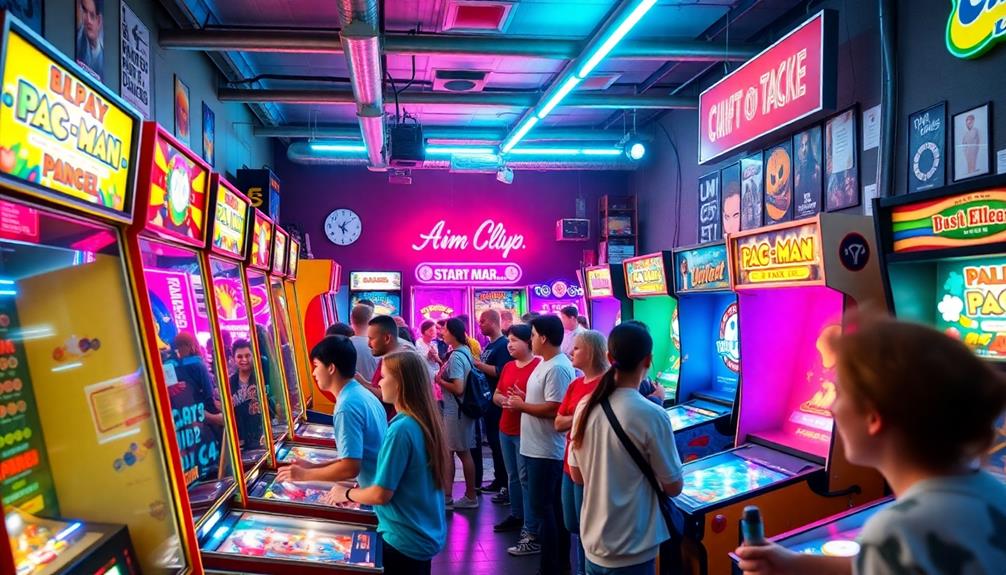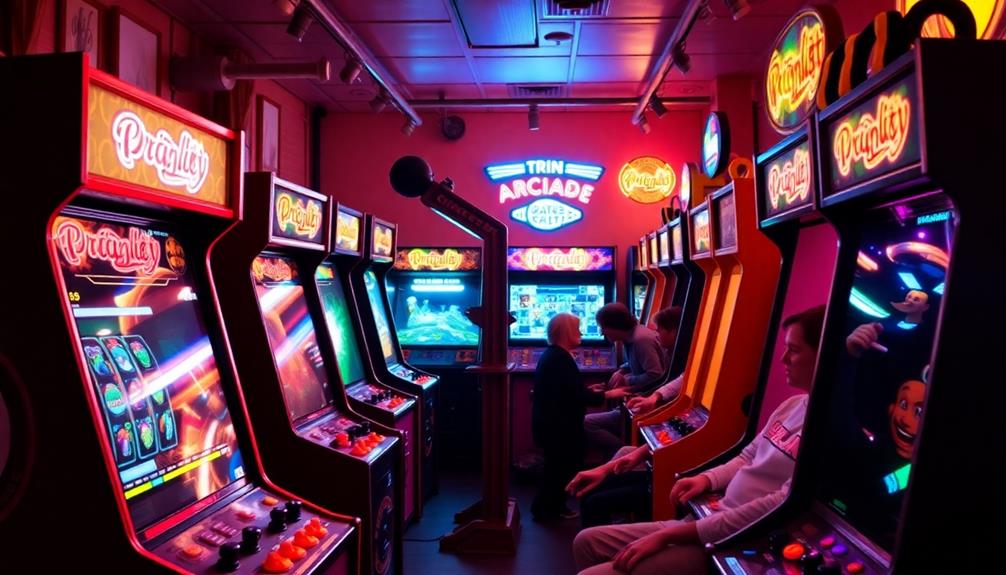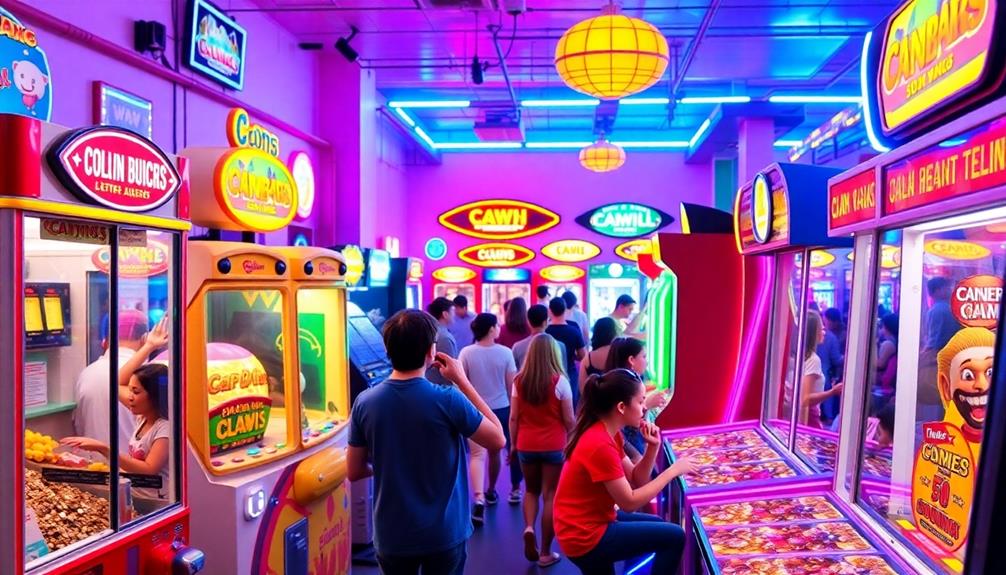Yes, arcade games can be a lucrative business option. The arcade industry is on the rise, with revenue expected to reach $3.2 billion by 2023 and an annual growth rate of 8.2% through 2028. Profit margins are strong, with monthly earnings ranging from $20,000 to $40,000 in prime locations. Families and young adults are key target markets, ensuring a consistent flow of customers. By offering unique experiences, holding events, and providing a diverse selection of games, you can attract more visitors. If you want to learn more about how to make your arcade a success, there is plenty more to discover.
Key Takeaways
- The U.S. arcade market is projected to grow at a CAGR of 8.2%, indicating strong potential for investment.
- Average weekly profits range from $1,100 to $2,000, with urban arcades achieving significant revenues.
- Target demographics include teenagers and families, ensuring diverse customer engagement and repeat visits.
- High-traffic locations and unique experiences are crucial for maximizing foot traffic and revenue.
- Engaging marketing strategies and community involvement can enhance visibility and attract a wider audience.
Current Market Trends
The arcade market is booming, and you might be surprised by how much it's evolving. The U.S. arcade market is projected to grow at a CAGR of 8.2% from 2023 to 2028, reaching an estimated revenue of $3.2 billion this year. This growth stems from increased consumer spending on leisure activities and a renewed interest in arcade games.
Additionally, the integration of unique experiences similar to authentic art auctions onboard in the cruise industry is making arcades more appealing to a diverse audience.
Current market trends reveal that modern arcades are blending advanced technology with diverse gaming experiences, appealing to new generations of gamers while shaking off the obsolete label. Nostalgia plays a significant role in this resurgence, as arcade bars combine retro and contemporary games to attract a wide audience.
Successful family entertainment centers are focusing on unique gaming experiences that keep customers coming back, which is essential for sustained revenue growth.
Industry experts are optimistic about the future, advocating for investments in arcade businesses as economically rewarding. They predict potential revenue of approximately $5.48 million by 2030, driven by the growing demand for alternative entertainment options.
This evolving landscape indicates that now's a great time to reflect on entering the arcade games market.
Profit Margins and Revenue
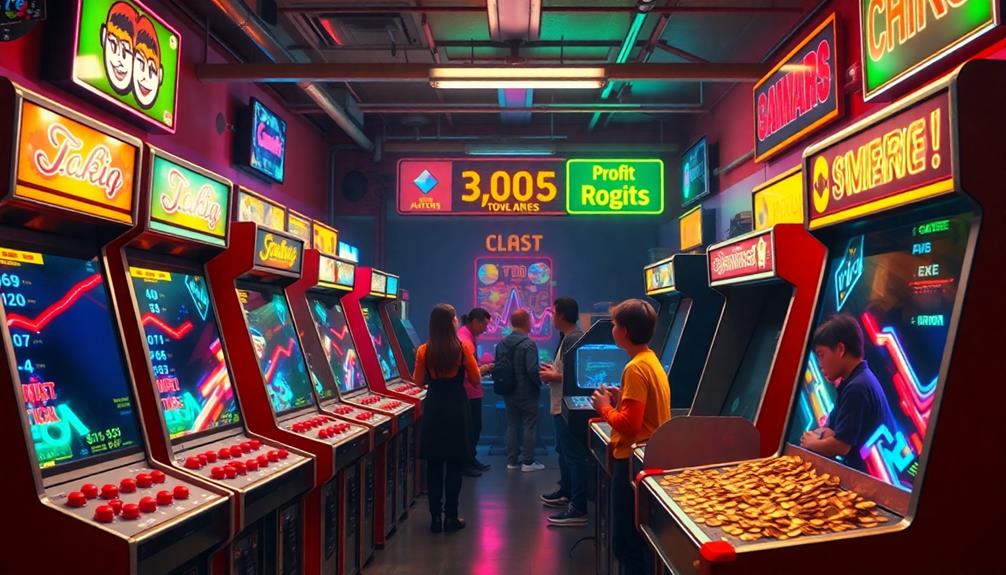
As the arcade market continues to grow, understanding the profit margins and revenue potential becomes essential for anyone considering this business. With average weekly profits ranging from $1,100 to $2,000, there's solid revenue potential when managed effectively. Urban arcades can generate monthly revenues up to $20,000, while premium locations can push that figure to $40,000.
Here's a quick breakdown of key financial metrics:
| Metrics | Figures | Notes |
|---|---|---|
| Average Weekly Profit | $1,100 – $2,000 | Solid revenue potential |
| Monthly Revenue | Up to $40,000 | Premium arcades |
| Gross Margins | 25% – 45% | Profit margins vary |
| Breakeven Point | 1,500 – 3,750 customers | Based on $15,000 fixed costs |
Profitability metrics show net margins averaging between 5% to 15% after covering operational costs. Understanding these figures will help you strategize effectively and gauge whether investing in arcade games aligns with your financial goals.
Target Demographics

Arcade games thrive on understanding their target demographics, which includes a mix of teenagers and young adults who crave both nostalgic and modern gaming experiences. Recently, the rise of modeling influencers has shown how social media can play a role in attracting younger audiences.
Your primary target audience is teenagers aged 13-19 and young adults aged 20-30, who often seek a fun and engaging environment to unwind. Families also represent an essential demographic, as they enjoy visiting arcades for communal entertainment that pairs gaming with food and beverages. This blend encourages longer visits and enhances the overall experience.
To maximize your revenue per visit, focus on creating an inviting atmosphere that encourages repeat business. Occasional visitors may come a few times monthly, but regular customers can visit weekly, greatly boosting your revenue through consistent spending.
Customer spending typically ranges from $10 to $25 per visit, and frequent visitors contribute greatly to your bottom line with repeat play and in-arcade purchases. By cultivating a loyal customer base across these demographics, you can increase the average customer lifetime value, estimated between $120 and $800, ensuring long-term profitability for your arcade.
Location and Foot Traffic

Choosing a high-traffic area is key to attracting customers to your arcade.
Consider locations that are close to other entertainment venues, as this can create a vibrant atmosphere that draws in crowds looking for fun activities.
If you target locations with the right demographics, like families and young adults, you'll likely see more repeat visits.
Plus, being near other entertainment options can boost your foot traffic even further, especially in areas known for unique party options that enhance celebrations.
High-Traffic Areas
High-traffic areas play an essential role in the success of arcade businesses. Locations like shopping malls and entertainment complexes not only boost visibility but also greatly enhance foot traffic. This increased customer exposure can lead to higher retention rates and profitability for your arcade business.
| Location Type | Benefits |
|---|---|
| Shopping Malls | High foot traffic, diverse demographics |
| Near Colleges/Universities | Captures younger audiences, frequent visits |
| Tourist Attractions | Attracts visitors seeking entertainment options |
When you're situated near complementary businesses, like restaurants and movie theaters, the synergy can be advantageous. Patrons might dine or watch a film and then decide to extend their outing by visiting your arcade. This creates an inviting atmosphere that encourages spending.
Research shows that well-placed arcades can generate impressive monthly revenues ranging from $20,000 to $40,000. By choosing a high-traffic area thoughtfully, you maximize your arcade's potential for profitability and guarantee it stands out as a go-to entertainment option.
Demographic Alignment
Selecting the right location isn't just about visibility; it's also about understanding who your potential customers are. When considering arcade games, you need to focus on demographics that align with your business model. High-traffic locations—like shopping malls, entertainment complexes, and family-oriented neighborhoods—are vital since they greatly increase foot traffic.
Your target audience primarily consists of teenagers aged 13-19 and young adults aged 20-30, who are likely to engage in gaming activities near their social hubs. Additionally, mastering the art of bug out bags can help in understanding how to prepare for unexpected situations that may arise in a bustling arcade environment.
Furthermore, placing your arcade near attractions such as restaurants, cinemas, or event venues can drive even more customers your way, enhancing your revenue potential. Urban areas usually present the best opportunities, with monthly revenues reaching up to $20,000 due to higher population density and diverse entertainment options available.
To guarantee you're making an informed decision, conducting thorough market research on local demographics and competition is essential. This approach helps you identify the ideal locations for your arcade, making sure that you're not just visible, but also relevant to the community's interests and preferences.
Types of Arcade Models

In today's entertainment landscape, various arcade models have emerged, each catering to different audiences and preferences.
Bar arcades combine classic arcade games with a focus on food and beverages, generating revenue from both gaming and social dining experiences. Additionally, high-quality content is essential for attracting and retaining customers, ensuring a memorable experience that encourages repeat visits.
Modern redemption arcades primarily target younger audiences, featuring engaging games and ticket redemption systems that keep players coming back for more.
Family Entertainment Centers (FECs) integrate arcade games with attractions like mini-golf and laser tag, appealing to families and providing a diverse entertainment experience. These centers create an environment where parents and kids can enjoy a full day of fun together.
Retro arcades emphasize nostalgia by showcasing vintage games, attracting older demographics seeking a throwback experience reminiscent of their youth. If you're looking for an authentic trip down memory lane, these spaces have you covered.
Virtual reality arcades take gaming to the next level by incorporating cutting-edge VR technology for immersive experiences, targeting tech-savvy audiences enthusiastic for interactive adventures.
Each arcade model offers unique benefits, so consider what aligns best with your target audience when venturing into this business.
Game Selection Strategies

When it comes to game selection strategies, you'll want to keep an eye on popular trends that attract a wide audience.
Understanding the history of pinball machines, for instance, can provide insights into classic games that still captivate players today, as seen in the evolution of pinball.
Balancing diverse game categories not only caters to different preferences but also boosts overall engagement.
Popular Game Trends
A well-thought-out game selection strategy is vital for any arcade looking to thrive in a competitive market. To maximize profitability, aim for a game mix of 60-70% redemption games, 20-30% video games, and 10-15% merchandisers or cranes. This combination not only caters to various player preferences but also enhances the entertainment experience.
Incorporating popular games like pinball machines can greatly increase your arcade's appeal, as showcased in the best rated pinball machines of 2024.
Stay ahead of popular game trends by regularly updating your offerings with new games to keep the arcade fresh and exciting. Data-driven decisions often outperform personal preferences, so prioritize games that align with market demand and have proven profitability.
Incorporating both skill-based and chance-based games helps attract a wider audience, fostering social interaction and engagement among players.
Don't overlook the value of consulting with distributors and monitoring game performance metrics. This practice is vital for optimizing your game selection and identifying low earners that may need replacement.
Diverse Game Categories
The success of your arcade hinges on a diverse game selection that caters to a wide range of players. Aim for a composition where 60-70% of your offerings are redemption games, 20-30% are video games, and 10-15% are merchandisers or cranes. This balance maximizes customer engagement and boosts profitability.
Including popular attractions like those found at best hotels with water parks can draw families looking for entertainment options as well.
Incorporating a mix of classic arcade games, modern video games, and even immersive VR experiences can attract both nostalgic older customers and tech-savvy younger audiences.
Regularly updating your game selection is essential; renewing your offerings every couple of years keeps customer interest high and encourages repeat visits.
Data-Driven Selection Strategies
Maximizing your arcade's success starts with leveraging data-driven selection strategies for your game lineup. Making data-driven decisions is vital for effective game selection, as popular and profitable games often differ from personal preferences. Stay in tune with market demand to maximize revenue.
Consulting with distributors can provide valuable insights into game performance, helping you identify trending games that resonate with your audience. A balanced game room composition is essential. Here's a recommended breakdown:
| Game Type | Percentage |
|---|---|
| Redemption Games | 60-70% |
| Video Games | 20-30% |
| Merchandisers/Crane | 10-15% |
| Other | 0-10% |
Regularly evaluating game performance allows you to spot low earners for trade-in, ensuring your arcade remains appealing and profitable. Refresh your game collection every couple of years. Utilize metrics like payout percentages for redemption games (around 30%) and ideal pricing strategies to enhance overall profitability and customer satisfaction. By implementing these strategies, you can create a thriving arcade business that attracts and retains customers.
Operational Costs Overview
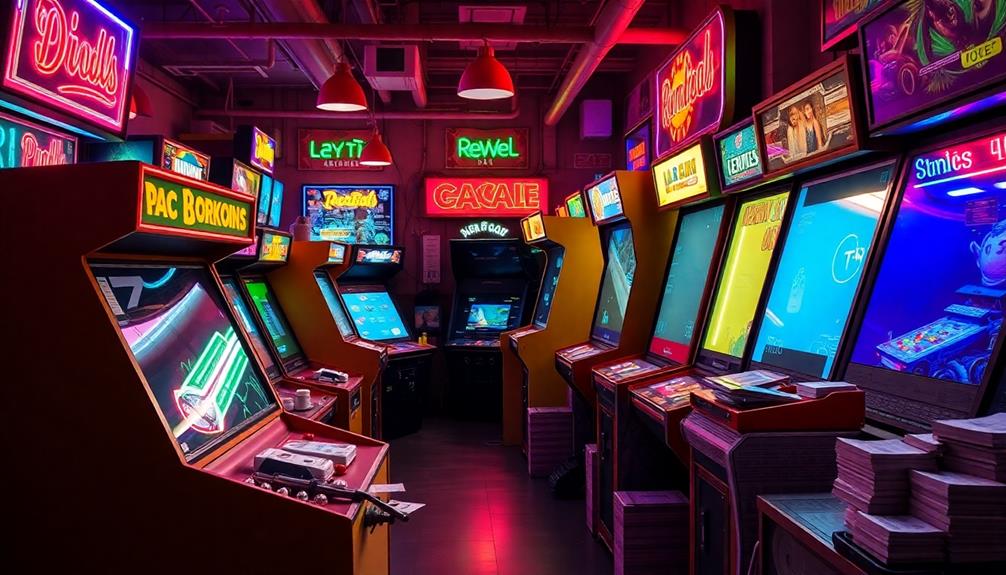
Understanding operational costs is essential for running a successful arcade business. You'll need to keep a close eye on several key expenses to maintain profitability. Here's a breakdown of the major operational costs you should consider:
1. Arcade Machines: These can account for over half of your total budget. Choosing the right machines and keeping them well-maintained is vital for attracting customers and maximizing revenue.
Additionally, implementing a strategy for investment diversification can help mitigate financial risks associated with large capital expenditures on arcade machines.
2. Staff Wages: This represents a significant portion of your ongoing expenses. Implementing effective staffing strategies can help you manage these costs while ensuring that your arcade runs smoothly.
3. Rent: Your location will heavily influence your rent. High-traffic areas usually come with higher rental prices, which can eat into your profits.
4. Utilities: Costs for electricity and water can fluctuate based on the size and usage of your arcade. Monitoring these expenses will help you keep your operational costs in check.
Additionally, don't forget to factor in other potential expenses like insurance and administrative costs.
Balancing these operational costs effectively will be key to your arcade's success and sustainability.
Marketing and Promotion Tactics
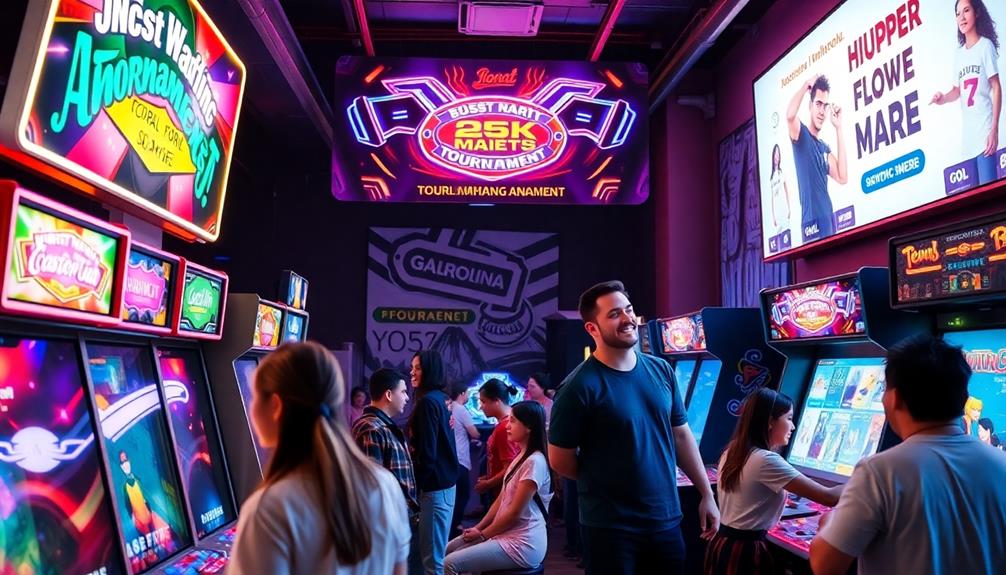
To thrive in the competitive arcade industry, effective marketing and promotion tactics are essential. Start by utilizing social media platforms to engage potential customers and promote special events. This approach leverages the growing trend of online community interaction, making it easier to connect with your audience.
Additionally, consider hosting unique camping experiences similar to those found in outdoor settings, as this can create a memorable atmosphere that resonates with customers.
Implement loyalty programs that reward repeat visits. Studies show that consistent customer engagement can greatly boost your overall revenue, so make sure to incentivize those who return.
Hosting themed events or tournaments can also attract diverse demographics and create buzz in the community, driving foot traffic and enhancing customer experiences.
Don't overlook cross-promotional opportunities with local businesses. Collaborations can expand your reach and increase visibility within the community, creating a win-win situation for both parties.
Additionally, consider using targeted local advertising strategies, such as flyers and partnerships with schools, to effectively reach families and young adults—your primary customer segments.
Community Engagement Benefits
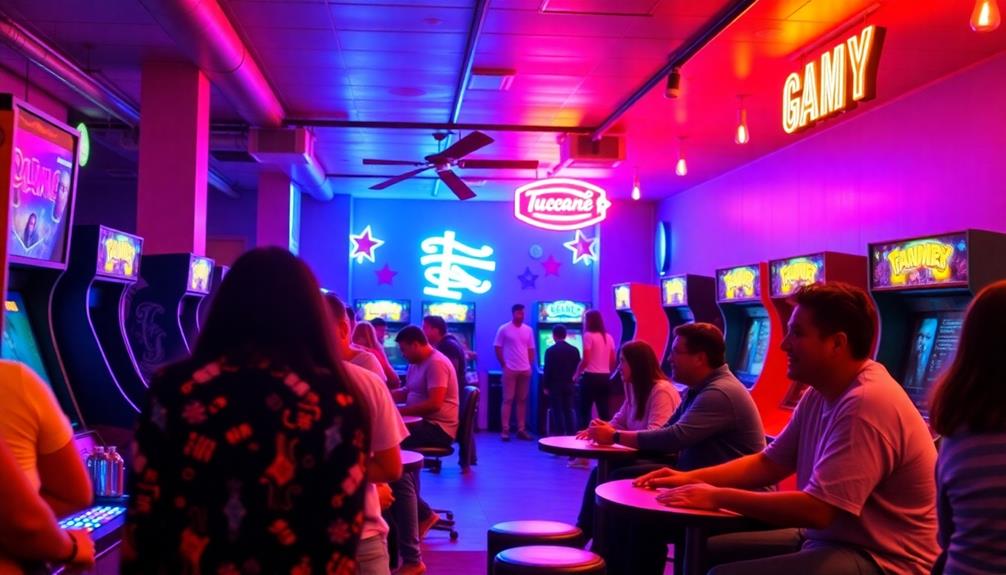
Arcades serve as vibrant community hubs, fostering social interactions and bringing people together through shared gaming experiences.
They create a unique environment where individuals and families can bond over games, making them essential entertainment venues in today's society.
Here are some key community engagement benefits:
- Tournaments and Events: Hosting gaming tournaments not only attracts gamers but also enhances local engagement, driving foot traffic and customer loyalty.
- Multi-Generational Appeal: Arcades encourage visits from people of all ages, allowing families to create lasting memories together while reinforcing community ties.
- Themed Nights: Regularly scheduled themed nights and promotional events can boost participation, helping establish the arcade as a go-to destination for entertainment.
- Partnerships with Local Businesses: Collaborating with local businesses for joint promotions enhances visibility and fosters a sense of belonging among customers, strengthening community bonds.
Future Outlook for Arcades

As community hubs continue to thrive, the future outlook for arcades looks promising. The US arcade market is projected to grow at a compound annual growth rate (CAGR) of 8.2% from 2023 to 2028, indicating strong potential for your arcade business. With estimated revenue for the arcade industry reaching $3.2 billion in 2023, driven by increased consumer spending on leisure activities, now's the time to contemplate entering this vibrant market.
Modern arcades are evolving, integrating diverse gaming experiences that attract a wider audience and enhance engagement. The nostalgia of classic games combined with contemporary gaming experiences appeals to both older and younger generations, making arcades a unique destination.
| Year | Projected Revenue (in $ billion) | CAGR (%) |
|---|---|---|
| 2023 | 3.2 | – |
| 2025 | 4.0 | 8.2 |
| 2028 | 4.8 | 8.2 |
| 2030 | 5.48 | – |
Given these trends, strategic investments in the arcade industry can yield significant returns, positioning you to capitalize on a growing market.
Frequently Asked Questions
Is an Arcade a Profitable Business?
Yes, an arcade can be a profitable business if you focus on unique gaming experiences, manage operations efficiently, and regularly update your game collection to attract repeat customers and enhance overall engagement.
Are Arcade Games a Good Investment?
Arcade games can be a great investment for you. With rising market growth and potential profits, focusing on unique experiences can attract customers. If you choose wisely, you could see significant returns in this evolving industry. In addition, the benefits of arcade games extend beyond just financial gains. They also provide a fun and energetic atmosphere for customers, which can lead to increased foot traffic and repeat business. Furthermore, offering a variety of arcade games can cater to a wide range of demographics, ensuring that there is something for everyone to enjoy.
What Arcade Games Make the Most Money?
Redemption games usually generate the highest profits, so focus on those with around 30% payout rates. High-demand video games and skill-based options also attract players, boosting your arcade's earnings considerably over time.
How Much Does It Cost to Start an Arcade Business?
Imagine a neon-lit paradise filled with laughter and competition. To start your arcade business, expect to invest around $300,000 for a small venue, factoring in game acquisition, ongoing expenses, and necessary permits.
Conclusion
To sum up, diving into the arcade business can be a thrilling ride, especially with the current market trends favoring nostalgia and social gaming. You'll find a mix of profit margins that can surprise you, and the right location could bring in steady foot traffic. By engaging your community and using effective marketing strategies, you'll create a hub of fun. Who knows? Your arcade could become the next local hotspot, bringing joy and connection to everyone who walks through your doors!
